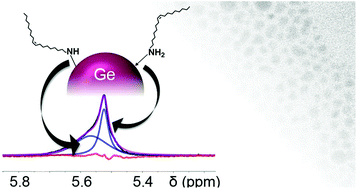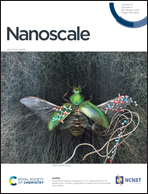Surface coordination chemistry of germanium nanocrystals synthesized by microwave-assisted reduction in oleylamine†
Abstract
As surface ligands play a critical role in the colloidal stability and optoelectronic properties of semiconductor nanocrystals, we used solution NMR experiments to investigate the surface coordination chemistry of Ge nanocrystals synthesized by a microwave-assisted reduction of GeI2 in oleylamine. The as-synthesized Ge nanocrystals are coordinated to a fraction of strongly bound oleylamide ligands (with covalent X-type Ge–NHR bonds) and a fraction of more weakly bound (or physisorbed) oleylamine, which readily exchanges with free oleylamine in solution. The fraction of strongly bound oleylamide ligands increases with increasing synthesis temperature, which also correlates with better colloidal stability. Thiol and carboxylic acid ligands bind to the Ge nanocrystal surface only upon heating, suggesting a high kinetic barrier to surface binding. These incoming ligands do not displace native oleylamide ligands but instead appear to coordinate to open surface sites, confirming that the as-prepared nanocrystals are not fully passivated. These findings will allow for a better understanding of the surface chemistry of main group nanocrystals and the conditions necessary for ligand exchange to ultimately maximize their functionality.



 Please wait while we load your content...
Please wait while we load your content...